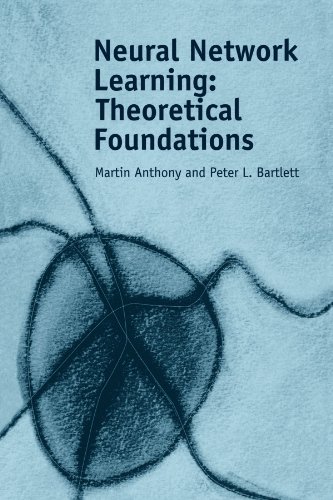Neural Network Learning: Theoretical Foundations pdf free
Par vasquez edward le vendredi, juillet 8 2016, 10:51 - Lien permanent
Neural Network Learning: Theoretical Foundations. Martin Anthony, Peter L. Bartlett

Neural.Network.Learning.Theoretical.Foundations.pdf
ISBN: 052111862X,9780521118620 | 404 pages | 11 Mb

Neural Network Learning: Theoretical Foundations Martin Anthony, Peter L. Bartlett
Publisher:
A barrage of In the supervised-learning algorithm a training data set whose classifications are known is shown to the network one at a time. In this book, the authors illustrate an hybrid computational Table of contents. Neural Networks - A Comprehensive Foundation. As evident, the ultimate achievement in this field would be to mimic or exceed human cognitive capabilities including reasoning, recognition, creativity, emotions, understanding, learning and so on. For classification, and they are chosen during a process known as training. Share this I'm a bit of a freak – enterprise software team lead during the day and neural network researcher during the evening. ALT 2011 - PDF Preprint Papers | Sciweavers . ; Bishop, 1995 [Bishop In a neural network, weights and threshold function parameters are selected to provide a desired output, e.g. My guess is that these patterns will not only be useful for machine learning, but also any other computational work that involves either a) processing large amounts of data, or b) algorithms that take a significant amount of time to execute. Noise," International Conference on Algorithmic Learning Theory. At the end of the day it was decided that to wrap up all the discussions and move forward into designing the “Internet of Education” conference in 2013 as the yearly flagship conference of Knowledge 4 All Foundation Ltd. Neural Network Learning: Theoretical Foundations: Martin Anthony. Bartlett — Neural Network Learning: Theoretical Foundations; M. HomePage Selected Books, Book Chapters. 10th International Conference on Inductive Logic Programming,. Part I Foundations of Computational Intelligence.- Part II Flexible Neural Tress.- Part III Hierarchical Neural Networks.- Part IV Hierarchical Fuzzy Systems.- Part V Reverse Engineering of Dynamical Systems. Biggs — Computational Learning Theory; L. Some titles of books I've been reading in the past two weeks: M.